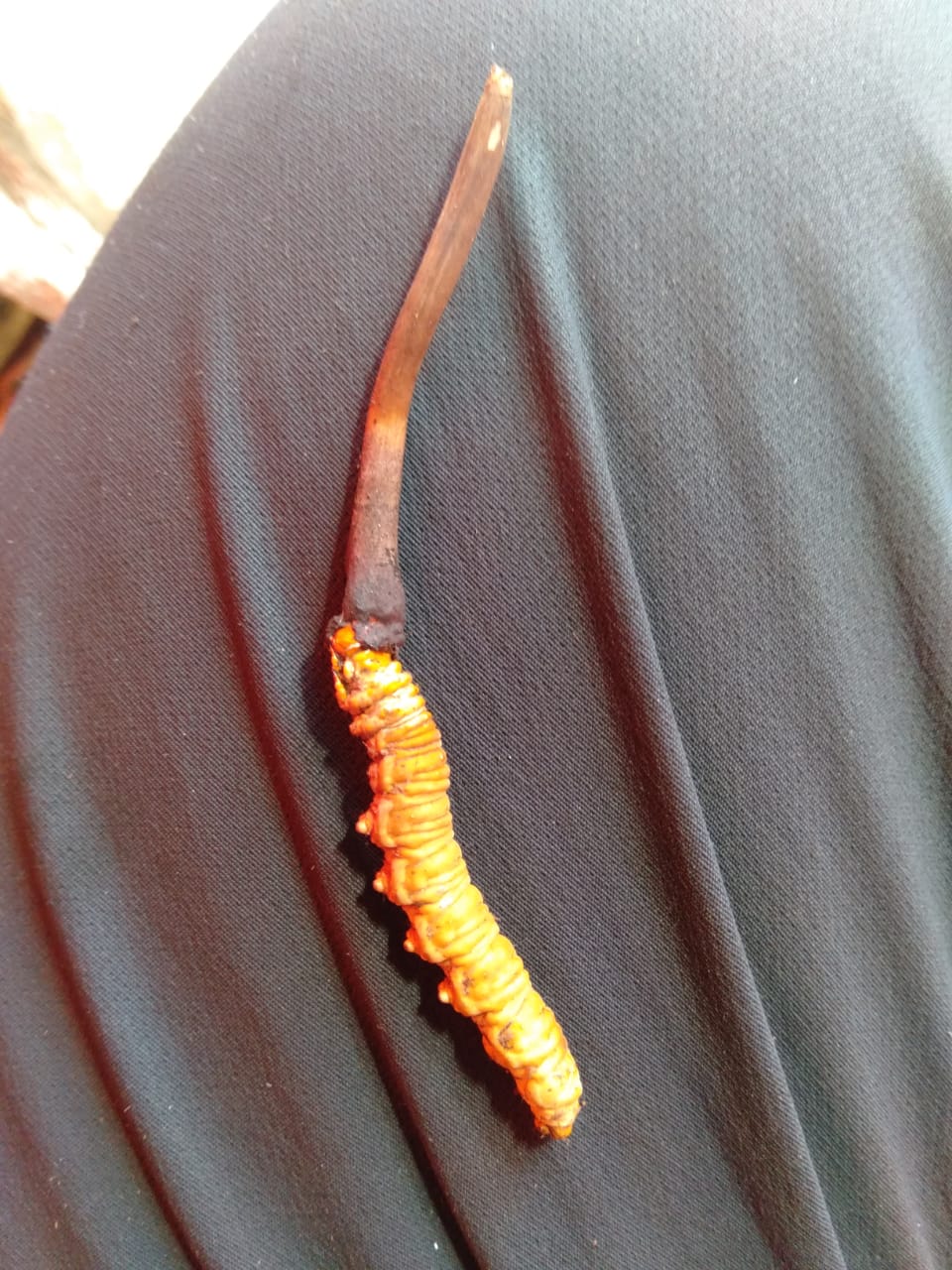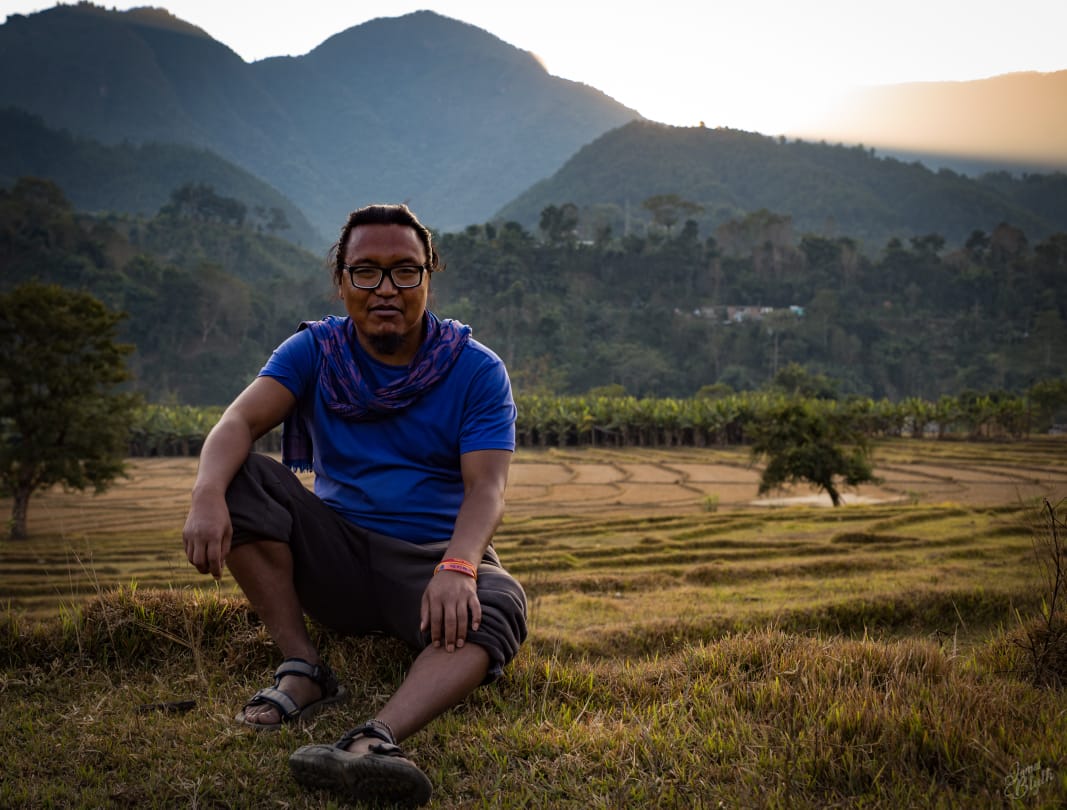Welcome to the Upper Dolpo region of Nepal, where the earth rises up over 4,000 metres to meet the sky. The area is famous for its vast panoramas, but also for something a bit more unusual: a kind of fungus that grows exclusively inside caterpillars.
Known as Yarsagumba, this weird half-fungus half-caterpillar is highly prized as a natural aphrodisiac. It’s also hard to find, making it incredibly expensive, which is why it’s sometimes referred to as “Himalayan Gold”.
For villages in the area, collecting and selling Yarsagumba is an essential source of their annual income. But as with most public events in 2020, collecting has been banned thanks to COVID-19.

According to regional lore, Yarsagumba was discovered generations ago when locals noticed their yaks getting frisky after eating brown sticks protruding from the mountain slopes. They decided to try the sticks themselves, and quickly realised these prongs of caterpillar-fungus might be worth money.
Now, Yarsagumba is traded all over the world for tens, even hundreds of thousands of dollars. In fact according to Bikash Baral, a research scientist from University of Turku in Finland, locals can earn over 25,000 Euros (over $40,000 AUD) for just one kilogram of the stuff.
We'll get back to the economic effects of Nepal's cancelled foraging season in a moment, but first a lesson in Ophiocordyceps sinensis, caterpillar fungus, or “summer grass winter worm” as it's known in Tibet, thanks to its summertime emergence. Basically, Yarsagumba is an extremely creepy fungus that grows out of caterpillars in long, golden brown fingers.
“In the high Himalayas we have the areas full of [fungal] spores and the spores either [get into the larvae] through the mouth or through the back of the larvae,” explains Baral.
The fungus then grows inside the larvae, first targeting the non-essential parts of the body so that the creature stays alive.
“When the fungus is fully grown then the vital organs are consumed and it basically breaks from the head,” says Bikash.
What he means is that this long, pointy growth emerges from the caterpillar’s face, killing it, before it pushes up through the grass. The growth then dries out in the wind, at which point it’s ready to harvest.

The harvest of Yarsagumba is the main source of income for locals like Acharya Rokaya Wangyal Rokaya, who can reportedly make up to 60 percent of their yearly income just from collecting the fungus. But the crop is found during a brief window of a few months each year, typically from May to June when the conditions are just right. Locals live off their earnings in those months for the rest of the year.
“I think the perfect conditions are less rain or snowfall in between the months of May and June,” says Rokaya, explaining that Yarsagumba needs a damp and cool environment. “If rain falls and the snow takes a long time to melt down the quality will be very bad.”
Elderly members of Rokaya’s village know exactly when the fungus grows, and remember the best spots to find it. But reaching these spots requires an annual three-hour trek into the mountains, for which they take everything they'll need to stay for several months, including livestock.
Entire families go hunting for the caterpillar-fungus, with children often taking months off school to help out. As Bikash explains: “when you are small you have got good eyesight.”
The technique for finding the fungus is simple: hunters simply walk up the hill while bent over, or crawling with their face down near the ground, searching for stick-like mushrooms.
The amount of Yarsagumba to be found varies every year, says Rokaya. “First day some get 50,” he says. “The first time I went there I got only two on the very first day. Next year I got 11 on the very first day, and last year I got nothing on the first day. It’s very embarrassing!”
After accumulating as much as they can carry, locals take the fungus back to their villages. Rokaya’s village cleans theirs, removing the dirt, and keeps them in cotton sacks inside their tents to dry.

For the highest quality fungus, prices can reach up to 1,300 NPR ($135 AUD) per piece—but last year, towards the end of the season, Rokaya says they dropped to 400 to 500 NPR ($4.80 to $6 AUD).
After they've purchased their bulk supplies of Yarsagumba, traders transport it to Kathmandu, or India, or even up to the Tibetan border. By the time the fungus reaches its final customers—either online or in stores—it can go for hundreds of thousands of US dollars.
There are several ways to ingest the fungus. You can simply take a bite, or cook it with milk; Rokaya has seen locals making tea with it, or cooking it in traditional Champa porridge. Either way is effective he says, meaning it leads to sexual arousal.
Bikash explains that there are two compounds in Yarsagumba that cause sexual arousal: Cyclosporine and Cordycepin, the latter of which has been shown to increase sperm production and testosterone levels in men. But not every piece of Yarsagumba contains the same amounts of active ingredients. He says that foragers squeeze the caterpillars to see how tightly packed they are to find the best pieces. The less “give” a caterpillar has, the more fungus it contains.
But no matter the quality, Yarsagumba is always expensive. So valuable is the aphrodisiacal fungus that it’s not unusual for locals to get into fights over it, or even murder one another.
“Small gang fights and robberies happen. Some even kill,” says Rokaya. “Yarsagumba is good for making people financially strong, but it spoils the area’s peaceful mindset.”
Collection of Yarsagumba has long been a part of life in the Himalayas—but the availability of the fungus is in sharp decline. Over the past 30 years, annual yields across the Tibetan Plateau have decreased by 10 to 30 percent.
This is largely due to over-harvesting, but climate change and increased cattle grazing have also reduced the numbers of larvae spawning in the mountains each year. As a result, the government has placed restrictions on who can collect Yarsagumba and where. The government also now takes a royalty rate of 30,000 NPR (about $360 AUD) per kilogram and limits the window in which people can harvest.
However, no one is allowed to go out and harvest Yarsagumba this year, due to restrictions under the COVID-19 pandemic. To date, Nepal has recorded 17,177 confirmed COVID-19 cases, and lockdown has just been extended from the end of June to July 22nd.
This signals a huge loss for Rokaya’s community, as well as so many others across the Nepalese Himalayas. It is perhaps unsurprising that there have been reports of people going to collect Yarsagumba in spite of the government’s bans.
“This year [the people in my community] will do more work on the fields and they can survive through this,” says Rokaya, who thinks that an enforced return to agriculture might actually be beneficial for locals like himself. “Due to Yarsagumba our self-sustainability is going down, because [it allows us to] buy foods that come from China or India… [meaning] few people take care of their fields. But this year they need to take care of their fields; they need to eat what grows.”
Follow Zoe on Twitter
from VICE https://ift.tt/2B3ZXjp
via cheap web hosting
No comments:
Post a Comment